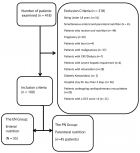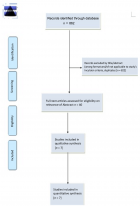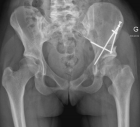Abstract
Research Article
A comparison of complications associated with nutrition between the patients receiving enteral or parenteral in the intensive care unit
Ahmet Eroglu*, Seyhan Sumeyra Asci and Ahmet Eroglu
Published: 29 September, 2020 | Volume 4 - Issue 1 | Pages: 013-018
The aim of this study was to investigate and compare the complications including infection and mortality associated with enteral and parenteral nutrition on patients in the ICU of a university hospital.
In this study, a total of 100 patients who were under follow-up in the ICU for two years were examined. In our study, demographic characteristics, the reason for admission, comorbidity, initial ICU laboratory values, morbidity and mortality during the follow-up period of the patients who only received enteral nutrition (EN) or parenteral nutrition (PN) were evaluated, and the results between two were compared as well as evaluating the complications within the groups.
The comparison of the reason for admission between the EN and PN groups showed that surgical reasons were significantly higher in the PN group. Nosocomial infections, the presence of infection and the development of sepsis were significantly higher in the EN group. The 28-day mortality rate was higher in the PN group compared to the EN group. The length of stay in the ICU and on mechanical ventilation was longer in the EN group. There was no significant difference in the 28-day mortality, readmission to the ICU and repeated endotracheal intubation between the two groups.
Because there is no statistical difference between EN and PN groups in point of infection and mortality, we conclude that the length of stay in the ICU and reason for admission play a more crucial role in the development of infection and on mortality rather than enteral or parenteral nutrition route.
Read Full Article HTML DOI: 10.29328/journal.ijcar.1001015 Cite this Article Read Full Article PDF
Keywords:
Enteral nutrition; Parenteral nutrition; Complication; Mortality; Morbidity; ICU
References
- ASPEN Board of Directors and the Clinical Guidelines Task Force. Guidelines for the use of parenteral and enteral nutrition in adult and pediatric patients. JPEN J Parenter Enteral Nutr. 2002; 26: 1SA-138SA. PubMed: https://pubmed.ncbi.nlm.nih.gov/11841046/
- Tamiya H, Yasunaga H, Matusi H, Fushimi K, Akishita M, et al. Comparison of short-term mortality and morbidity between parenteral and enteral nutrition for adults without cancer: a propensity-matched analysisi using a national inpatient database. Am J Clin Nutr. 2015; 102: 1222-1228. PubMed: https://pubmed.ncbi.nlm.nih.gov/26447149/
- Eroglu A. The effect of intravenous alanyl-glutamine supplementation on plasma glutathione levels in intensive care unit trauma patients receiving enteral nutrition: the results of a randomized controlled trial. Anesth Analg. 2009; 109: 502-505. PubMed: https://pubmed.ncbi.nlm.nih.gov/19608826/
- Moore FA, Feliciano DV, Andrassy RJ, McArdle AH, Booth FV, et al. Early enteral feeding, compared with parenteral reduces postoperative septic complications. Ann. Surg. 1992; 190:172-182. PubMed: https://pubmed.ncbi.nlm.nih.gov/1386982/
- Singer P, Blaser AR, Berger MM, Alhazzani W, Calder PC, et al. ESPEN guideline on clinical nutrition in the intensive care unit. Clin Nutr. 2019; 38: 48-79. PubMed: https://pubmed.ncbi.nlm.nih.gov/30348463/
- Taylor BE, McClave SA, Martindale RG, Warren MM, Johnson DR, et al. Guidelines for the Provision and Assessment of Nutrition Support Therapy in the Adult Critically Ill Patient: Society of Critical Care Medicine (SCCM) and American Society for Parenteral and Enteral Nutrition (A.S.P.E.N.). Crit Care Med. 2016; 44: 390-438. PubMed: https://pubmed.ncbi.nlm.nih.gov/26771786/
- Heidegger CP, Darmon P, Pichard C. Enteral vs. parenteral nutrition for the critically ill patient: a combined support should be preferred. Current Opin Crit Care. 2008; 14: 408-414. PubMed: https://pubmed.ncbi.nlm.nih.gov/18614904/
- Heyland DK, Dhaliwal R, Drover JW, Gramlich L, Dodek P. Canadian clinical practice guidelines for nutrition support in mechanically ventilated, critically ill adult patients. J Parenteral Enteral Nutr. 2003. 27: 355-373. PubMed: https://pubmed.ncbi.nlm.nih.gov/12971736/
- Zaloga GP. Parenteral nutrition in adult inpatients with functioning gastrointestinal tracts: assessment of outcomes. Lancet. 2006; 367: 1101-1111. PubMed: https://pubmed.ncbi.nlm.nih.gov/16581410/
- Liu CL, Du Z, Lou C, Wu C, Yuan Q, et al. Enteral nutrition is superior to total parenteral nutrition for pancreatic cancer patients who underwent pancreaticoduodenectomy. Asia Pacific J Clin Nutr. 2011; 20.2: 154-160. PubMed: https://pubmed.ncbi.nlm.nih.gov/21669582/
- Harvey SE, Parrott F, Harrison DA, Bear DE, Segaran E, et al. Trial of the route of early nutritional support in critically ill adults. N Engl J Med. 2014; 371: 1673-1684. https://pubmed.ncbi.nlm.nih.gov/25271389/
- Grau T, Bonet A, Rubio M, Mateo D, Farré M, et al. Liver dysfunction associated with artificial nutrition in critically ill patients. Critical Care. 2007; 11: R10. PubMed: https://pubmed.ncbi.nlm.nih.gov/17254321/
- Tao Y, Tang C, Feng W, Bao Y, Yu H. Early nasogastric feeding versus parenteral nutrition in severe acute pancreatitis: A retrospective study. Pak J Med Sci. 2016; 32: 1517-1521. PubMed: https://pubmed.ncbi.nlm.nih.gov/28083056/
- Reignier J, Boisramé-Helms J, Brisard L, Lascarrou JB, Ait Hssain A, et al. Enteral versus parenteral early nutrition in ventilated adults with shock: a randomised, controlled, multicentre, open-label, parallel-group study (NUTRIREA-2). The Lancet. 2018; 391: 133-143. PubMed: https://pubmed.ncbi.nlm.nih.gov/29128300/
- Blaser AR, Starkopf J, Alhazzani W, Berger MM, Casaer MP, Deane AM, Fruhwald S, Hiesmayr M, et al. Early enteral nutrition in critically ill patients: ESICM clinical practice guidelines. Intensive Care Med. 2007; 43: 380-398. PubMed: https://pubmed.ncbi.nlm.nih.gov/28168570/
- Yan X, Zhou FX, Lan T, Xu H, Yang XX, et al. Optimal postoperative nutrition support for patients with gastrointestinal malignancy: A systematic review and meta-analysis. Clinical Nutrition. 2017; 36: 710-721. PubMed: https://pubmed.ncbi.nlm.nih.gov/27452745/
- Işıl CT, Türk HŞ, Totoz T, Oba S. Reanimasyon ünitemizin bir yıllık nütrisyon profili. Ş.E.E.A.H. Tıp Bülteni. 2013; 47: 147-150.
- Cotogni P. Management of parenteral nutrition in critically ill patients. World J Crit Care Med. 2017; 6: 13-20. PubMed: https://pubmed.ncbi.nlm.nih.gov/28224103/
- Moore FA, Moore EE, Jones TN, McCroskey BL, Peterson VM. TEN versus TPN following major abdominal trauma-reduced septic morbidity. J Trauma. 1989; 29: 916–923. PubMed: https://pubmed.ncbi.nlm.nih.gov/2501509
- Park JS, Chung HK, Hwang HK, Kim JK, Yoon DS. et al. Postoperative nutritional effects of early enteral feeding compared with total parental nutrition in pancreaticoduodectomy patients: a prosepective, randomized study. J Korean Med Sci. 2012; 27: 261-267. PubMed: https://pubmed.ncbi.nlm.nih.gov/22379336/
- Metin ZG, Özdemir L. Yoğun Bakımda Enteral Pompa ile Beslenen Hastalarda Gelişen Komplikasyonlar ve Etkileyen Faktörlerin Belirlenmesi. Hacettepe Üniversitesi Hemşirelik Fakültesi Dergisi. 2015; 2: 20–29.
Figures:

Figure 1

Figure 2

Figure 3

Figure 4

Figure 5

Figure 6
Similar Articles
-
Submitral Ventricular Pseudoaneurysm: Unusual and Late Complication of Cardiac SurgeryMarzia Cottini*,Amedeo Pergolini,Giordano Zampi,Vitaliano Buffa,Paolo Giuseppe Pino,Federico Ranocchi,Riccardo Gherli,De Marco Marina,Carlo Contento,Myriam Lo Presti,Francesco Musumeci. Submitral Ventricular Pseudoaneurysm: Unusual and Late Complication of Cardiac Surgery . . 2017 doi: 10.29328/journal.hacr.1001001; 1: 001-004
-
Endovascular treatment of complex cerebral arterial saccular aneurysms with different methods of coiling: 14 years of experience reviewDmytro V Scheglov*,Stanislav V Konotopchik,Maryna Y Mamonova,Oleg E Sviridyuk. Endovascular treatment of complex cerebral arterial saccular aneurysms with different methods of coiling: 14 years of experience review. . 2017 doi: 10.29328/journal.hacr.1001002; 1: 005-019
-
Evolution of anaesthesia in transapical aortic valve implantation Running head: Anaesthesia and transcatheter valveMarzia Cottini*, Lappa A,Donfrancesco S,Francesco Musumeci. Evolution of anaesthesia in transapical aortic valve implantation Running head: Anaesthesia and transcatheter valve . . 2017 doi: 10.29328/journal.hacr.1001003; 1: 020-023
-
The incidence of hemodynamic and respiratory adverse events in morbidly obese presenting for Bariatric surgeryTomi Myrberg*,Veronica Atterhem,Magnus Hultin . The incidence of hemodynamic and respiratory adverse events in morbidly obese presenting for Bariatric surgery. . 2018 doi: 10.29328/journal.ijcar.1001006; 2: 009-017
-
Assessing the Neurocognitive function effects of ketamine in Cardiac Surgical patientsDemet Dogan Erol*. Assessing the Neurocognitive function effects of ketamine in Cardiac Surgical patients . . 2018 doi: 10.29328/journal.ijcar.1001007; 2: 018-022
-
Anaesthetic management of an elderly patient with ischaemic heart disease and previous MI undergoing elective inguinal hernia repair: Case reportKhaleel Ahmad Najar(Senior Resident)*,Anka Amin(Assistant Professor),Mohammad Ommid(Associate Professor). Anaesthetic management of an elderly patient with ischaemic heart disease and previous MI undergoing elective inguinal hernia repair: Case report. . 2020 doi: 10.29328/journal.ijcar.1001013; 4: 001-003
-
A comparison of complications associated with nutrition between the patients receiving enteral or parenteral in the intensive care unitAhmet Eroglu*,Seyhan Sumeyra Asci,Ahmet Eroglu. A comparison of complications associated with nutrition between the patients receiving enteral or parenteral in the intensive care unit. . 2020 doi: 10.29328/journal.ijcar.1001015; 4: 013-018
-
A witnessed intra-operative blood transfusion-related air embolism under epidural anaesthesia for vesicovaginal fistula repairGyadale AN*,Adeyanju BT,Ayegbusi EO,Adeyiolu AT,Olabode AA,Suberu SO,Olajide MA. A witnessed intra-operative blood transfusion-related air embolism under epidural anaesthesia for vesicovaginal fistula repair. . 2022 doi: 10.29328/journal.ijcar.1001018; 6: 001-003
-
To evaluate the stress response to tracheal intubation by macintosh laryngoscope and intubating laryngeal mask airwaySomika Agarwal*,Sapna Bansal. To evaluate the stress response to tracheal intubation by macintosh laryngoscope and intubating laryngeal mask airway. . 2022 doi: 10.29328/journal.ijcar.1001020; 6: 007-013
Recently Viewed
-
An Instance of Green-tinted Urine Related to the use of PropofolBindhya Maharjan*, Jeevan Singh, Shibesh Chandra Mishra, Saubhagya Neupane. An Instance of Green-tinted Urine Related to the use of Propofol. Int J Clin Anesth Res. 2024: doi: 10.29328/journal.ijcar.1001024; 8: 001-004
-
Minimising Carbon Footprint in Anaesthesia PracticeNisha Gandhi and Abinav Sarvesh SPS*. Minimising Carbon Footprint in Anaesthesia Practice. Int J Clin Anesth Res. 2024: doi: 10.29328/journal.ijcar.1001025; 8: 005-007
-
European Clinical Laboratory, Molecular and Pathological (ECMP) criteria for prefibrotic JAK2V617F-Thrombocythemia and Polycythemia Vera versus MPL515- and CALR-Thrombocythemia and Myelofibrosis: From Dameshek to Michiels 1950-2018Jan Jacques Michiels*,Zwi Berneman,Wilfried Schroyens,Fibo W J ten Kate,King Lam,Hendrik De Raeve. European Clinical Laboratory, Molecular and Pathological (ECMP) criteria for prefibrotic JAK2V617F-Thrombocythemia and Polycythemia Vera versus MPL515- and CALR-Thrombocythemia and Myelofibrosis: From Dameshek to Michiels 1950-2018. Int J Bone Marrow Res. 2019: doi: 10.29328/journal.ijbmr.1001002; 2: 001-017
-
Primary myelofibrosis is not primary anymore since the discovery of MPL515 and CALR mutations as driver causes of mono-linear megakaryocytic and dual megakaryocytic granulocytic myeloproliferation and secondary myelofibrosisJan Jacques Michiels*,Hendrik De Raeve. Primary myelofibrosis is not primary anymore since the discovery of MPL515 and CALR mutations as driver causes of mono-linear megakaryocytic and dual megakaryocytic granulocytic myeloproliferation and secondary myelofibrosis. Int J Bone Marrow Res. 2019: doi: 10.29328/journal.ijbmr.1001003; 2: 018-026
-
The PVSG/WHO versus the Rotterdam European clinical, molecular and pathological diagnostic criteria for the classification of myeloproliferative disorders and myeloproliferative neoplasms (MPD/MPN): From Dameshek to Georgii, Vainchenker and Michiels 1950-2018Jan Jacques Michiels*,Hendrik De Raeve. The PVSG/WHO versus the Rotterdam European clinical, molecular and pathological diagnostic criteria for the classification of myeloproliferative disorders and myeloproliferative neoplasms (MPD/MPN): From Dameshek to Georgii, Vainchenker and Michiels 1950-2018. Int J Bone Marrow Res. 2019: doi: 10.29328/journal.ijbmr.1001004; 2: 027-050
Most Viewed
-
Evaluation of Biostimulants Based on Recovered Protein Hydrolysates from Animal By-products as Plant Growth EnhancersH Pérez-Aguilar*, M Lacruz-Asaro, F Arán-Ais. Evaluation of Biostimulants Based on Recovered Protein Hydrolysates from Animal By-products as Plant Growth Enhancers. J Plant Sci Phytopathol. 2023 doi: 10.29328/journal.jpsp.1001104; 7: 042-047
-
Sinonasal Myxoma Extending into the Orbit in a 4-Year Old: A Case PresentationJulian A Purrinos*, Ramzi Younis. Sinonasal Myxoma Extending into the Orbit in a 4-Year Old: A Case Presentation. Arch Case Rep. 2024 doi: 10.29328/journal.acr.1001099; 8: 075-077
-
Feasibility study of magnetic sensing for detecting single-neuron action potentialsDenis Tonini,Kai Wu,Renata Saha,Jian-Ping Wang*. Feasibility study of magnetic sensing for detecting single-neuron action potentials. Ann Biomed Sci Eng. 2022 doi: 10.29328/journal.abse.1001018; 6: 019-029
-
Pediatric Dysgerminoma: Unveiling a Rare Ovarian TumorFaten Limaiem*, Khalil Saffar, Ahmed Halouani. Pediatric Dysgerminoma: Unveiling a Rare Ovarian Tumor. Arch Case Rep. 2024 doi: 10.29328/journal.acr.1001087; 8: 010-013
-
Physical activity can change the physiological and psychological circumstances during COVID-19 pandemic: A narrative reviewKhashayar Maroufi*. Physical activity can change the physiological and psychological circumstances during COVID-19 pandemic: A narrative review. J Sports Med Ther. 2021 doi: 10.29328/journal.jsmt.1001051; 6: 001-007

HSPI: We're glad you're here. Please click "create a new Query" if you are a new visitor to our website and need further information from us.
If you are already a member of our network and need to keep track of any developments regarding a question you have already submitted, click "take me to my Query."


















































































































































